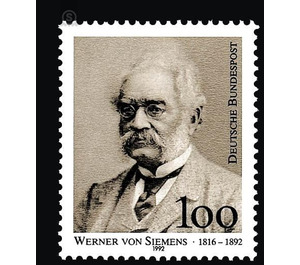100th anniversary of death of Werner von Siemens - Germany / Federal Republic of Germany 1992 - 100 Pfennig
Theme: Calender
| Country | Germany / Federal Republic of Germany |
| Issue Date | 1992 |
| Face Value | 100.00 |
| Color | brown |
| Perforation | K 13 3/4: 14 |
| Printing Type | Multi-color rotogravure |
| Stamp Type | Postage stamp |
| Item Type | Stamp |
| Chronological Issue Number | 1515 |
| Chronological Chapter | GER-BRD |
| Michel ID | BRD 1642 |
| SID | 524628 |
| In 44 Wishlists | |
Werner von Siemens is one of the great founding figures of the German electrical engineering industry; he was an engineer, inventor and industrialist; his relief in the hall of honor of the Deutsches Museum bears the tribute: »A scholar and a technician at the same time, he, the first one, with an ingenious mind, made the electric current of humanity serviceable.« Siemens was extremely successful in technical fields and its scientific achievements are probably less known. He first worked in electrochemistry and electrometallurgy, but above all in international telecommunications services in telegraphy. In 1847 he founded the telegraph construction company of Siemens & Halske in Berlin with the university mechanic Johann Georg Halske (1814-1890). For submarine cable manufacture, he invented a machine for maintaining a permanent insulation, with which a seamless gutta-percha casing could be pressed around the wires; For cable laying he built and operated his own cable ship "Faraday" together with his brothers. His most famous accomplishment today was the manufacture of electric machines - the most significant of which was the dynamo-electric machine, which introduced modern high-voltage power engineering and a priority dispute between Germany and England, the Oskar von Miller (1855-1934), as a witness himself a pioneer of electrical engineering and the founder of the Deutsches Museum in Munich, in the ceremonial address on the occasion of the commemoration of his 100th birthday in 1916 in the former Kgl. The great merit of Werner Siemens for the invention of the dynamo and thus the founding of electrical engineering is not diminished by the fact that the Englishman Wheatstone [Charles, 1802-1875] on 15 2.1867 in the Royal Society [ London], more than 2 months after Siemens designed its dynamo machine [as a series machine], and a month after Siemens publicly presented this invention to the Academy of Sciences [in Berlin on January 17, 1867], a machine model [as a shunt machine] in which the dynamoelectric principle was also used ... ". And Miller continued: "The powerful currents of the new machines were of particular importance for the operation of electric trains: in 1879 Siemens demonstrated the first electric locomotive in the Berlin trade exhibition, in 1881 he built the first electric train [between Berlin and Lichterfelde], and In 1884 he already wrote that the development of Berlin as a city depends on the implementation of an underground electric tram network. "According to literature, Siemens' outstanding special position among all pioneers of electrical engineering rests on its being - perhaps only comparable to the American inventor Thomas A. Edison (1847-1931) - worked in all areas of electrical engineering and that he was successful as a theorist, practitioner and entrepreneur at the same time. In addition, he was politically, economically and socio-politically creative and also engaged in association politics: from 1862 to 1866 he is a member of the Prussian Chamber of Deputies for the district of Lennap-Solingen and creates the foundations for the 1877 German Reich Patent Law. The Siemens Pension Fund, established in 1872, is modeled on the preparation of Bismarck's social legislation, which was developed from 1881 onwards. The foundation of the Physikalisch-Technische Reichsanstalt (now Physikalisch-Technische Bundesanstalt PTB) took place in 1887 on his initiative - supported by him supported by a plot including buildings. In 1883, he already demanded state-financed basic research, which today, of course, is accepted. He created the term electrical engineering in 1879 and in the same year co-founded the Elektrotechnische Verein Berlin (today: Verband Deutscher Elektrotechniker VDE). The photo template for the special postage stamp shows Siemens after recovery from some fever attacks in the summer of his death year 1892. Werner von Siemens had aligned his company internationally; It exists worldwide today and plays a leading role in all sectors of electrical engineering, communications engineering and information technology. The first dynamo and the first locomotive have been preserved and can be visited in the Deutsches Museum. (Text: Dr.-Ing. Friedrich W. Heilbronner, German Museum, Munich)
| Condition | Name | In Stock | Price | Price + Shipping | Store | |
|---|---|---|---|---|---|---|
 | Unmounted Mint ** | 100th anniversary of death of Werner von Siemens - Germany / Federal Republic of Germany 1992 - 100 Pfennig | 6 | US $1.07 | US $4.27 |  FILATELIELOKET (0) FILATELIELOKET (0)Shipping US $3.20 Minimum Order US $2.67 |


